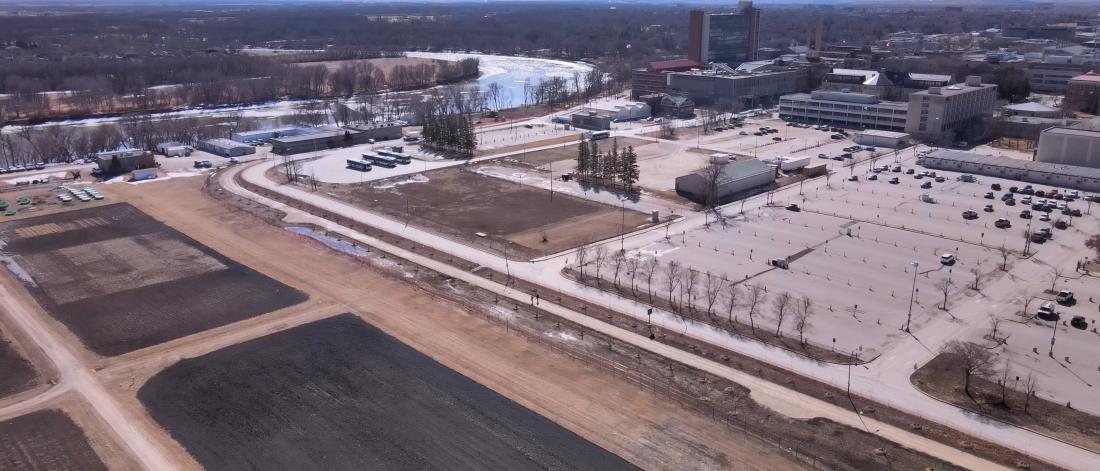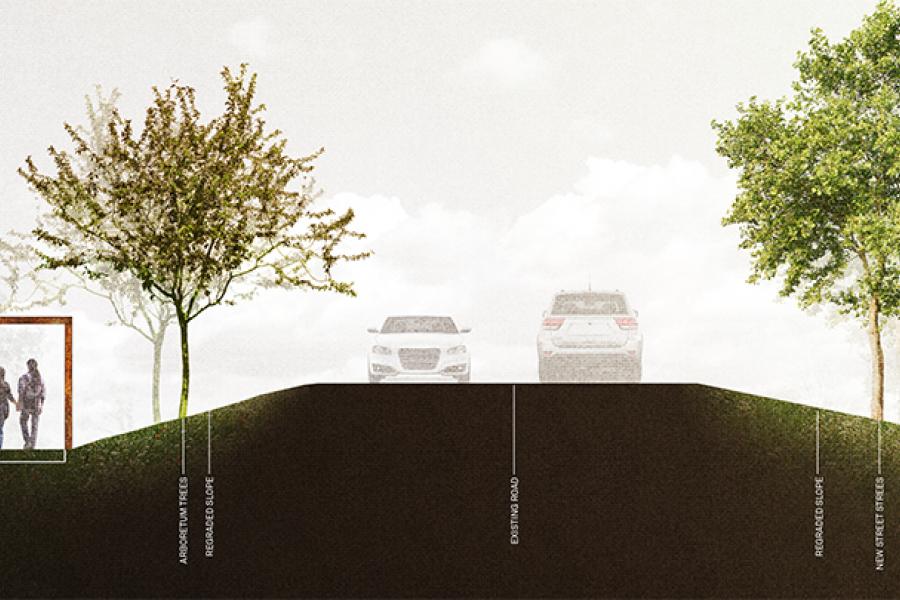Eastern Transportation Corridor collaborative workshop

The Eastern Transportation Corridor collaborative workshop was held in May of 2021. This interdisciplinary, two-day workshop encouraged participants to reimagine the spaces along the corridor which runs along the eastern edge of the Fort Garry campus, adjacent to the Point Lands, and includes Freedman Crescent, Saunderson Street and Dysart Road. Participants of the workshop considered ideas and concepts for three seating and wayfinding nodes along the multi-use path by integrating Indigenous Planning and Design Principles within the spaces. During the two-day workshop, there were presentations and guidance from mentors – including members from the Indigenous campus community, faculty and industry professionals.
Schedule
Thursday, May 13
9:00 a.m. Welcome
Land Acknowledgement
Opening Prayer
Overview of day
Opening poem by Duncan Mercredi, Poet Laureate (2020-2021)
9:30 a.m. Project overview and housekeeping
Eastern Transportation Corridor at the University of Manitoba
Presented by Vanessa Jukes Strutt, Project Manager, Architectural and Engineering Services
Participants will gain an understanding of the site, its location and the project goals. The Indigenous Planning and Design Principles (IPDP) will be introduced and integrated throughout the workshop. The principles have been established to guide planning and design on all University lands and campuses:
The various components of campus planning and design are not isolated entities, but interdependent and interconnected. An Indigenous way of seeing/being that recognizes the interdependence of all things underlies the principles. Effective planning must recognize that all components of a place – such as the land, water, transportation networks, buildings, infrastructure, open spaces, and the people that inhabit it – are linked in complex ways. Each one affects the other, and they must be viewed holistically.
Housekeeping
Goals and expectations of the collaborative workshop.
10:30 a.m. Break
Participants can use this time as a networking opportunity.
10:45 a.m. Cultural Landscapes: History of this Place
The Cultural Landscape of the Fort Garry Campus: Land, Use and Occupancy Prior to 1900
The new report entitled, 'The Cultural Landscape of the Fort Garry Campus: Land, Use and Occupancy Prior to 1900,' released by the campus planning office explores the pre-colonial history of the lands. The presentation will emphasize the Indigenous and environmental histories of the land on which the campus sits, making them visible and significant components of the landscape, and recognizing them as a crucial part of the campus’ culture, heritage and identity.
Presented by Jordan Mykietowich, University of Manitoba Alumini; Operations & Marketing Specialist, Intent Planning Group Inc. and Kevin Handkamer, Landscape Planner, Campus Planning Office
11:15 a.m. Group breakout session
Interdisciplinary workshop groups will form.
Workshop groups will begin Stage 1 - Project Inception and Initiation.
12:00 p.m. Lunch
Participants can use this time as a networking opportunity.
1:00 p.m. Water
Poem on Water by Duncan Mercredi, Poet Laureate (2020-2021)
Water Governance
Presented by Dr. Stewart Hill, community member of Manitou Sakahigan (God’s Lake) First Nation; United Nations Sustainable Development Goal 6 Hub Working Group and Dr. Shirley Thompson, Professor, Natural Resources Institute; United Nations Sustainable Development Goal 6 Hub Working Group
The presentation will highlight interdisciplinary research on water systems which help to build sustainable, resilient communities in Manitoba and across Canada, including research with Indigenous communities, management of water quantity and quality issues and the impact of climate change on our water systems.
1:55 p.m. Group breakout session
Workshop groups will begin Stage 2 - Concept Design.
4:30 p.m. Pin up and reporting out
Each designated group leader will provide a brief five minute presentation on their group's progress.
5:00 p.m. Day ends
Develop action-plan for the second day of the collaborative workshop.
Friday, May 14
9:00 a.m. Welcome back
Brief review of the previous day.
9:30 a.m. Ecologies
Poem on Ecologies by Di Brandt, Poet Laureate (2018-2019)
~Owtsira Ohkara, Stories Across the Fire: Our Journeys Through Indigenous and Land-Based
Presented by Dan Henhawk, Assistant Professor, Faculty of Kinesiology and Recreation Management and Jay Johnson, Professor, Faculty of Kinesiology and Recreation Management
We would like to indicate that this is a work in progress, part history, part contemporary, part personal and part universal. With that, we would like to present to you a video that captured our words in a more natural environment.
In discussing the colonial haunting of Western outdoor recreation and outdoor education, Mullins, Lowan-Trudeau and Fox (2016) note how the privileging of western values related to the land, the appropriation of Indigenous practices and the perpetuation of uncritical celebration of European exploits is implicated in perpetuating neo-colonial understandings of Indigenous Peoples. They argue that to correct the “split head” of outdoor recreation and education, the engagement of Indigenous knowledge is critical, particularly with respect to the following core characteristics: a valuing of practical application and/or embodiment, the importance of relationality, a commitment to the ethical qualities of knowledge acquisition and knowledge sharing, and the valuing of wholistic expressions of personhood. Additionally, Paraschak and Heine (2020) advocate the potential for co-transformation through the shared understandings of ILBE. We align ourselves with these perspectives and we argue that ILBE is critical to a re-imagining outdoor recreation and outdoor education but that ILBE also has the potential to transform how we approach recreation and leisure studies to be more inclusive, to perhaps realize the transformative potential of leisure(s) to lead change and meet the calls for unabashed challenges to increasingly worrisome resurgences of xenophobia and oppression.
Through story, we will relate our shared journey and the history and future of Indigenous Land-Based Education in our Faculty, Kinesiology and Recreation Management and on campus. This discussion will relate the perspectives of 2 scholars at the University of Manitoba engaged in their own process of co-transformation, of learning about ILBE and searching for a way through the academic stronghold that privileges Western knowledges about leisure, sport and recreation. We would like to create a dialogue about the importance of ILBE and the imperatives we see for academic programs of recreation and leisure studies and the engagement of reconciliation. To do this, we relate our story, so far, that relates our struggles to define Indigenous land-based education and our increasing belief in the transformative power of Indigenous knowledge and ILBE.
Raven Medicine Cloud
Presented by the Office of Sustainability
This Indigenous story map focuses on select landscape elements that are currently found along UM riverbank forests. The online story map features Wild Bergamot, Red-Osier Dogwood, Wild Red Raspberry, Stinging Nettle, Black Ash and Common Burdock. These species were selected by the Indigenous Land-Based Knowledge Working Group as important species to Indigenous cultures in Manitoba.
10:20 a.m. Group breakout session
Workshop groups will continue Stage 2 - Concept Design.
11:00 a.m. Creative Expressions on and for the Land
Poem on Creative Expressions on and for the Land by Duncan Mercredi, Poet Laureate (2020-2021)
Disrupting the Settler Landscape: Public Art as Indigenous Acts of Resurgence in Winnipeg
Presented by Honoure Black, Ph.D Candidate, Faculty of Architecture; Instructor, Environmental Design Program
The presentation will explore specific-sites of contemporary public art in Winnipeg that perform as powerful markers, to (re)claim, (re)placemake and (re)map the landscape such as: Niimaamaa (2019), by Jaimie Isaac, K.C. Adams and ValVint; Electrical Currents (2018), by Julie Nagam; O-ween du muh waun; We Were Told (2018), by Rebecca Belmore and Osvaldo Yero; and Rooster Town Kettle and Fetching Water (2019), by Ian August.
Voices of the Land: Indigenous Design and Planning from the Prairies
Presented by the Indigenous Design and Planning Students Association (IDPSA), Faculty of Architecture
The publication features 16 Indigenous students representing a range of nations across Turtle Island, and spanning all four departments in the Faculty of Architecture. The publication also features conversations with leading Indigenous designers and educators in the Faculty of Architecture.
11:50 a.m. Group breakout session
Workshop groups will engage in a brief activity.
12:00 p.m. Lunch
Participants can use this time as a networking opportunity and to explore other groups' progress.
1:00 p.m. Group breakout session
Workshop groups will begin Stage 3 - Detailed Design and Concepts.
4:00 p.m. Pin up and reporting out
Each designated group leader will provide a brief five minute presentation on their group's progress.
Wrap-up and next steps.
4:30 p.m. Closing remarks
Closing poem by Di Brandt, Poet Laureate (2018-2019)
Closing Prayer
Steering Committee
Vanessa Jukes Strutt: Project Manager, Architectural and Engineering Services; MALA, CSLA, PMP
Michaela Peyson: Promotion and Outreach Assistant, Office of Sustainability; Master’s Candidate, Department of Landscape Architecture
Kale Kostick: Director (Acting), Office of Sustainability
Honoure Black: Ph.D Candidate, Faculty of Architecture; Instructor, Environmental Design Program, Faculty of Architecture
Christine Cyr: Associate Vice-President Indigenous – Students, Community and Cultural Integration
Laura Forsythe: Ph.D Candidate, Department of Native Studies; Métis Inclusion Coordinator
Ryan Gorrie: Senior Associate, Brook McIlroy; MAA, MRAIC
Kevin Handkamer: Landscape Planner, Campus Planning Office
Naomi Ratte: Master’s Candidate, Department of Landscape Architecture; Co-Founder Indigenous Design & Planning Students Association (IDPSA)
Grace Redhead: Executive Assistant for the Director, National Centre for Truth and Reconciliation
Marla Robson: Indigenous Student Recruitment Officer
Maria Zbigniewicz: Environmental Specialist
Resources
Key plan
The Eastern Transportation Corridor (ETC) multi-use path connects to the existing pathway on the south side of campus along Freedman Crescent where it eventually reaches the Great Trail at King’s Drive. A future multi-use path connection is planned to connect the Wallace Building on the north side of campus to Southwood Lands, which will lead to the Great Trail connection at D’Arcy Drive.
Tree planting plan
In the fall of 2020, reforestation of the corridor began with the planting of 230 trees along the multi-use path. The species composition focuses on native species such as cottonwood, bur oak, Manitoba maple and hackberry. Other species well suited to the growing conditions of the Fort Garry campus such as scots pine and silky white willow are included to increase diversity and resiliency of the urban forest.
Wayfinding spaces
The ETC Collaborative Workshop will focus on concepts for the design of three (3) seating and wayfinding spaces along the pathway. Each space offers different views and connections with the campus lands including the Point Lands to the east and the Red River riparian corridor along the north side. Other points of interest along the pathway lend themselves to the design of future spaces, such as the river corridor along the south side of campus.


